About the physical impossibility of “feedbacks”
Although the title may be a bit misleading, as some minor feedbacks actually do exist, they do not play the role “climate science” wants to make us believe. There is very straight forward logical evidence denying the basic claim and to my knowledge, it has not been discussed so far. Also this shall be a synopsis of my previous work with an argument Lord Monckton1 tries to rightfully bring forward.
In “climate science” there is a strict distinction between forcings and feedbacks. While forcings are any cause of temperature change, feedbacks are innate enhancers or mitigators to it. The point is, whatever forces the temperature to change, feedbacks would indiscriminately react to it. Whether the forcing is anthropogenic CO2, changes in albedo due to land use, or varying intensity of solar radiation, feedbacks only would react to changes in temperature, not caring about the cause.
With “climate science” this mechanism is conveniently exploited to explain how CO2 shall be the tail that wags the climate dog. Also it has a history on its own. Originally there was this idea of CO2 causing all the GHE directly. As the “science” progressed, this had to be given up. Instead CO2 would only make up for a decent share in the GHE, while the rest was caused by feedbacks to CO2. Imagine you removed all CO2 from the atmosphere, then it would (only) be a couple of degrees colder, but because of it, the atmosphere would hold far less vapor. With a large chunk of the “GHG” vapor gone, temperatures would even lower and so on.
Though not directly, CO2 would still be responsible for the biggest part of the GHE. And although the GHE is erroneously assumed to have a magnitude of 33K, this would only represent the status quo with a given albedo. If large parts of the Earth froze, the albedo would increase, thereby allowing even far lower temperatures than the notorious 255K. It is this perspective that raises a lot of uncertainty over the actual magnitude of feedbacks, making climate sensitivities beyond 4 or 5K thinkable.
Now the point Monckton is trying to make is about how feedbacks are supposed to know the difference between a forcing like CO2, and a forcing like the sun?! Let us, for simplicity, assume the sun warmed Earth to 255K, CO2 would add another 8K, then why would feedbacks enhance the CO2 forcing by a factor of 3 or 4, but totally ignore the 255K forcing? Again remember, that feedbacks are only responding to temperature and do not care about the cause. And if the remaining 25K (255 + 8 + 25 = 288) were a feedback to a total forcing of 263, then feedbacks would only add about 10% (= 25 / 263) to the original forcings. Accordingly feedbacks were almost negligible and ECS would necessarily be very low, like in the 1.2K range.
As I am writing this, just like when I read Monckton’s article, I can literally smell the electric short cuts in the minds of people thinking about it. Monckton’s analogy of electric circuits may have contributed to it, since I am pretty certain it does not promote the understanding of this logic for most people. You would be asking, is the base magnitude of 255K of the same nature as the 8K forcing on top of it? “Climate science” suggests it is not, so who are you to judge? Complicated!
Actually it is not. We can easily build a mental bridge if we consider changes in TSI (total solar irradiance). If the sun, for whatsoever reasons, would become stronger or weaker, would that be a forcing? Well, of course yes. Based on it, we can run a simple logical experiment.
The Solar System
Let us look on the solar system as whole. We have planets close to the sun being hot and planets far away, which are cold, trivial. As I did not want to invest too much time, I just used temperature data from Wikipedia and that is not the only reason why they need to be taken with some salt.
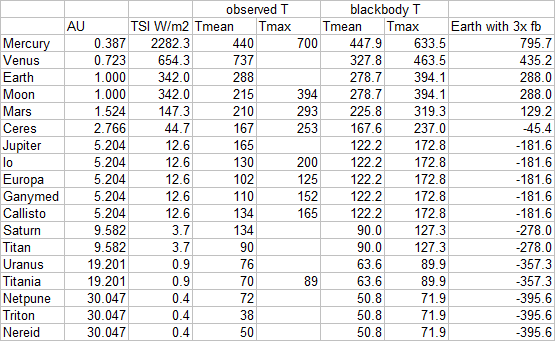
AU stands for astronomical units and describes the average distance from the sun. One AU equals the distance of Earth to sun btw. Next is TSI (total solar irradiance) as a function of that distance to the sun. Then we have average, and in some cases, maximum temperatures as taken from Wikipedia. Next we have the theoretic blackbody temperatures at the respective distances from the sun, both average and maximum. And eventually there is something I am yet going to explain.
Just let me note that a blackbody temperature is the temperature a theoretic blackbody sphere would attain at a given distance from the sun. This is 278.7K in the case of Earth, while in “climate science” the blackbody temperature of Earth would usually be claimed to be 255K. The latter figure is based on the notion Earth was a blackbody with an albedo of 0.3. That is while blackbodies by definition do not reflect light and thus will NOT have an albedo > 0. It is one of many stupidities in “climate science”. As to why albedos are best to be ignored see here.
There are reasons why the temperatures “observed” do not perfectly match the theoretic blackbody temperature. Let me name them..
a) In most instances these temperatures are likely incorrect and only estimates. With Venus, Mars and Titan probes have landed there and were able to measure the temperature directly, just like on Earth. As all of them have atmospheres, it is pretty easy to do, once you get there. Without an atmosphere however things become complicated. Essentially you will have to measure emissions, which are a function of temperature AND emissivity. As the emissivity is unknown, you can not tell the temperature. These given temperatures are just educated guesses. The Jovian moons for example likely have all very similar surface temperatures, but different emissivities. At least the average over all four of them (119K) is very close to the theoretic black body temperature of 122K.
b) What is surface? With gas giants the “surface” is arbitrarily defined as 1 bar pressure level, to make it more comparable to Earth. In reality there is of course no surface, nothing to land on or so. At 1 bar pressure level one would expect some GHE at least. Notably Venus has about 340K at the same pressure level, pretty close to the black body temperature, with only a moderate GHE. At the solid surface of Venus there are an impressive 92 bar, and accordingly hot 737K. At the same pressure level of 92 bar Jupiter has over 500K, making it the second hottest planet of the solar system, if we compared apples with apples. The point is, Venus does not really have a massive GHE, but only just a massive atmosphere.
c) Most moons (and Mercury) have some bound rotations, meaning they always face the body they orbit with the same side. Relative to the sun these rotations are slow and combined with a lack of atmosphere, the surface turns hot in the sun, and very cold on the dark side. As radiation is a function of temperature by the power of 4, temperatures on the lit side will not turn all too hot. For instance quadrupling solar radiation increases the temperature only to 141.4% (= 4^0.25). Because of it, an arithmetic average of surface temperatures makes little sense in these instances. A perfect example is the moon of Earth, with a geometric average of about 276K, perfectly consistent with the black body, but an arithmetic average of only ~215K. Because of this problem I added maximum temperatures for such objects, if available, as they are more reasonable.
d) Apart from GHEs, or should I say atmosphere effects, there is yet another reason why surface temperatures can deviate from that of a perfect black body. That is so if the short wave reflectivity differs significantly from long wave reflectivity. As I have discussed the water sphere that Earth largely is, is a better absorber than emitter, making it somewhat warmer than a black body.
All these considerations set aside and without allowing for them, it is still pretty obvious how the different celestial bodies obey this black body temperature. The chart gives the distance from the sun in AUs on a logarithmic scale vs. temperatures. The blue line gives the theoretic black body temperatures, the blue circles average surface temperatures for the respective objects. It starts with Mercury to the left, then Venus, Earth & Moon and so on. Moons of course have the same distance from the sun as their host planet. And it is the same with the red curve giving maximum temperatures.
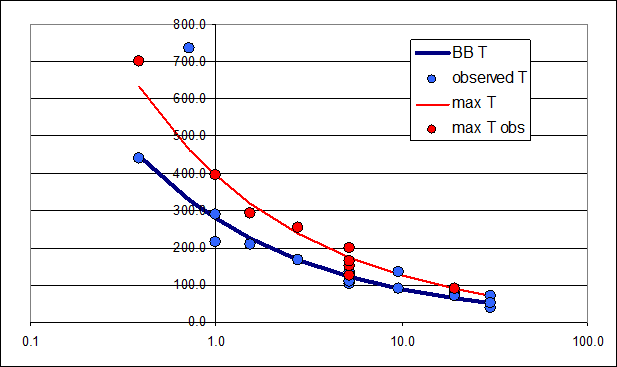
Except for Venus, for the named reasons, all bodies behave more or less as expected. Close to the sun they are hot, further away they get colder. No big point to make here, it is all way too obvious.
What would Archimedes do?
But now there is one big question which this article is all about. What if we moved Earth, either closer to, or further from the sun? For instance, if we placed Earth onto the orbit of Mars, TSI would shrink from 342W/m2 to only 147.3W/m2. As a forcing this should reduce the black body temperature by 53K, and naturally we would assume something like it happening to Earth. Rather than 288K Earth would only have a frosty 235K. Yet this temperature is then just enough to stay above the blue line. No matter where you put Earth, you would expect it to become warmer, or colder, staying close to this blue line and essentially behaving like all other celestial bodies.
But here is the problem; we forgot about “climate science”. Moving Earth provides forcings, and these forcings will get enhanced by feedbacks. If we assume a feedback factor of three, which is roughly the central estimate current ECS predictions are based on, then the climate of Earth needs to be far more sensitive. At the orbit of Mars, Earth will not just cool by a forcing of -53K, but by another -106K due to feedbacks. The red line in the chart below shows how the climate of Earth would behave given such a feedback.
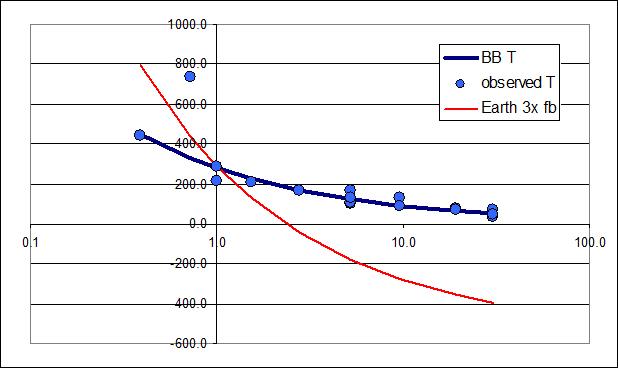
At only 2.3 AU from the sun Earth would fall to 0K, the absolute minimum temperature. Beyond this, it would even fall below, which of course is physically impossible. Also such a climate sensitivity would be totally inconsistent with all other celestial bodies in our solar system. And even if we reduced the feedback factor to 2 for instance, it would not remedy the problem.
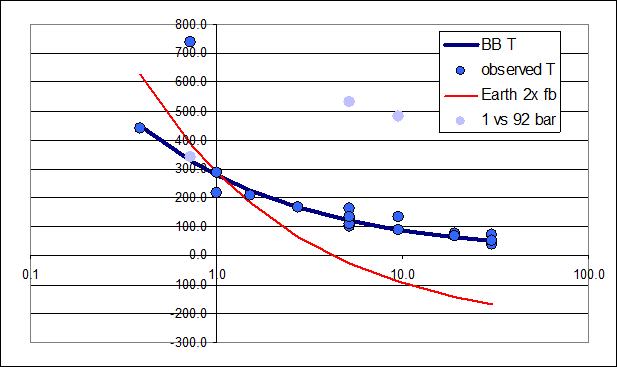
How could this even happen? “Climate science” has to a certain degree been “inspired” by Venus, while all the other celestial bodies (as well as physics and logic) were simply ignored. Venus has always served as the role model for what could happen to Earth with a “runaway GHE”. Reality is a bit different however, and just to be cheeky, I added a little of information to the chart above. The light blue dots give the temperatures of Venus at 1 bar, and that of Jupiter and Saturn at 92 bar.
As we can see Venus is just a little bit warmer than a black body there, despite its atmosphere consisting almost entirely of CO2. That is about 950,000ppm! Both Jupiter and Saturn on the other side, at the respective 92 bar pressure levels, are about equally warmer than a black body as the surface of Venus is. In other words, it is not so much about what the atmosphere consists of, but rather how strong it is.
Back to the feedback problem
Of course any respectable “climate scientist” would instantly respond with “you can not do this!”. Why not? An honest answer might be “cause it is disastrous for our science”. A more pragmatic, eel like squirming response, might go like feedbacks only applying within a certain temperature range, with Earth incidentally in the center of it. Let us make the case for it.
As we have established (strong) positive feedbacks can not possibly work throughout the spectrum of thinkable forcings. If feedbacks as claimed by “climate science” were yet to exist, they would need to be restricted to a certain temperature envelope. Beyond it, there would need to be “tipping points” where feedbacks turn from positive to negative. The climate sensitivity profile of Earth, so to say, would look something like in the chart below.
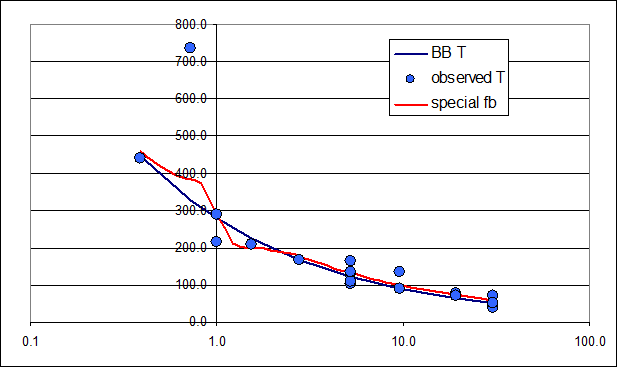
Is it credible? No, not really. In fact it looks pretty absurd. Yet it is the only way to combine the feedback narrative with the named physical restrictions. Let us not forget, I am playing the Devil’s advocate here, in favour of “climate science”. And this, as awkward as it looks, is pretty much the best possible defense.
“Climate science” itself, to my knowledge, has never stepped up to argue this defense, as it does seem to be even aware of the problem. But there are plenty of questions related to it. Why would such feedbacks only work within a certain range? Where would they turn from positive to negative, and why? How comes the feedback profile of Earth would be so specific and apparently different from all other celestial bodies? And where is the evidence?
These are questions deserving answers, but there are none. The logical implications of the feedback narrative were simply ignored. Given that at least the positive WV feedback is based on nothing but (intentionally?) erroneous calculations, as discussed here and here, it is no surprise. Also this is the dynamic manifestation of the same problem Monckton refers to. “Climate science” argues what it needs for a certain narrative, and not what the physical evidence tells us.
Summary
Feedbacks are a conditio sine qua non for the climate crisis narrative. Apparently this “need” is also their origin, rather than physical evidence. Sticking to the latter, we are rather left wondering what this unscientific non-sense is all about. Both on the micro level, based on line by line calculations, as on the macro level as presented here, the evidence not just does not support the claim of significant positive feedbacks, but rather speaks strictly against it. On top of that we can fairly well see not just what went wrong, but also why it did.



Comments (2)
Russell
at 07.10.2022Menschmaschine
at 17.09.2023